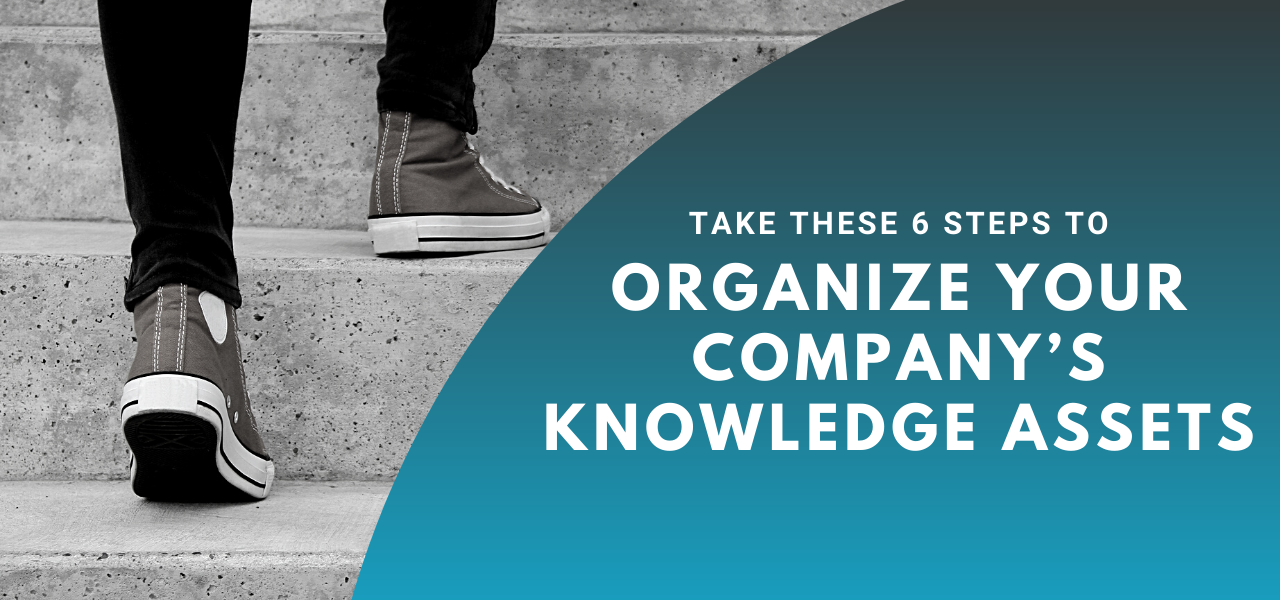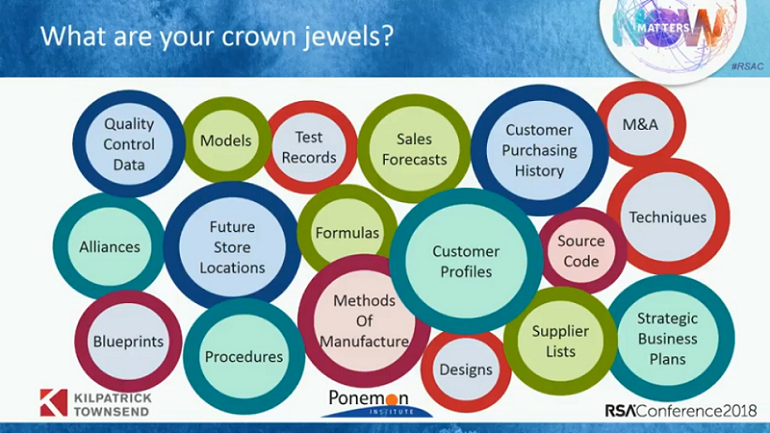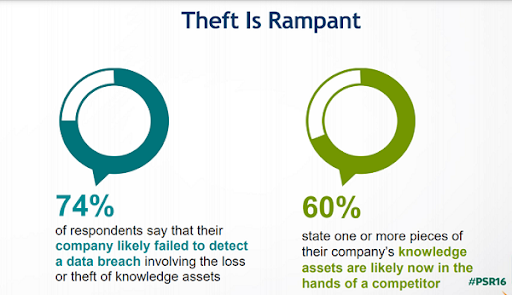
How To Organize Your Company’s Knowledge Assets In 6 Simple Steps
The practice of Knowledge Management carries many benefits for your organization, including increased efficiency, better decision-making, improved customer service, and more. With these benefits in mind, let’s get into specific knowledge management tactics you can use to maximize the use of your company’s knowledge assets - six steps you can start working through today!
- Step 1: Determine What you Need to Know
- Step 2: Categorize Your Knowledge Assets
- Step 3: Have Clear Corporate Data Security Policies
- Step 4: Promote Knowledge Sharing
- Step 5: Secure Valuable Knowledge
- Step 6: Get the Right Technology
Step 1: Determine What You Need to Know
To kick-start your knowledge management efforts, you must determine what you need to know to run an efficient, profitable organization.
Ask two strategic questions:
- First, what do you know as a company? List all knowledge expertise at your disposal.
- Second, what do you need to know? Identify the insights you must have to win, whether or not you have them.
Your goal is to fill the gap between the two. Identify the key knowledge you must possess in order to be competitive in the market, but don’t yet have it in your coffers. That’s the know-how you must focus on.
Once you’ve determined what you must know, move to the second step.
Step 2: Categorize Your Knowledge Assets
An integral element of knowledge management is having an agile info classification system.
Develop a system that segments info based on three aspects:
To start with, consider the type of info. Group your data according to various categories for easy access when needed. These classes can include customer profiles, policy documents, suppliers and partners list, business plans, customer purchasing history, sales administration database, source code, and more.
Categorize knowledge assets in a way that makes sense to your organization.
Next, prioritize knowledge assets depending on their niche, goals, or competitive environment. Sit down with your team and ask yourselves:
- Of all our knowledge assets, which ones can’t we live without? (High-value assets)
- Which assets are important but don’t seriously affect the organization’s operations? (Medium-value assets)
- Which basic assets are part of our knowledge repository? (Low-value assets)
The third and final way to label your knowledge assets is through their security-related access levels.
You must make it easy for people to access the info they need to do their job effectively. As a case in point, a developer must have login details to work on your company website design. But you must restrict access, so workers and partners get the necessary knowledge and no more. This keeps your data safe while circulating enough info to move the business forward.
Here are the data accessibility levels you can use:
- General Data: Available to everyone inside the organization and your strategic partners.
- Local Data: Knowledge only shared with people within your company, but not to outsiders.
- Partner Data: Data that’s shared with outsiders like partners and suppliers.
- Confidential Data: Info assets meant for the eyes of senior C-level executives only and on a need-to-know basis for the rest of the staff members.
Data categorization primes you for the next step—data security policy formulation.
Step 3: Have Clear Corporate Data Security Policies
Having straightforward company data policies is a must-have for efficient knowledge asset management. Policies help all stakeholders know what and what not to do with the data at their disposal.
Your data policies must be:
- Clear: Your knowledge assets policy documents must be simple and unambiguous. Everyone who reads it must grasp it straight away to avoid confusion. Clarity and how you phrase certain things can be your lifeline should there be a data breach that ends up in a court of law.
- Thorough: You must have in-depth data policies. Cover all the bases. Who can access what data, when, and how can they get the info they need? With whom can you share the knowledge in your hands? What happens if you break the rules?
- Widely Circulated: Make sure every stakeholder knows your data policies. From field workers to office staff, from senior management to junior staff, from suppliers to partners, from board members to the sales team, everyone must be familiar with knowledge assets policy documents.
- Penal: State exactly what happens to employees who are negligent with company info. What penalties await those who deliberately share trade secrets with competitors? The penalties must be heavy enough to deter negative behavior and keep everyone true.
Strong data governance policies go a long way in knowledge usage and protection.
Step 4: Promote Knowledge Sharing
Having ironclad data policies isn’t enough. You must develop a knowledge-sharing culture at your workplace.
Not all knowledge lives in computer hard drives.
Workers also have significant expertise locked up deep in their minds. For instance, a vastly experienced team member has access to tried-and-tested contextual knowledge that new workers can’t find anywhere. A 10-year sales vet knows more about selling than anyone in the marketing department will ever know in their lifetime.
That’s why knowledge sharing is crucial.
It creates an environment that encourages the impartation of education to staff members who need it to do their jobs better.
Here’s how to promote knowledge sharing and collaboration in your company:
- Run mentorship programs where senior staff members advise and share their rich experiences with new workers. Pair up less experienced workers with experienced staff on important projects, so they learn and grow.
- Encourage cross-departmental collaboration. Let the marketing team attend the sales team meetings, for example.
- Promote a culture of sharing that goes beyond formal meetings. Build a mindset that encourages workers to share whatever they feel will help a fellow worker, even in unstructured contexts.
- Create a physical space for knowledge sharing. Have a work area designated for collaborative breakout sessions.
- Build organizational trust so workers feel safe to share unreservedly.
Your knowledge-sharing culture will help you generate gobs of precious data. You must secure it. That’s what we will focus on next.
Step 5: Secure Valuable Knowledge
You must protect sensitive company info at all costs.
Why?
Knowledge theft is unbridled. Unscrupulous competitors will stop at nothing to lay their hands on data that may give them an advantage on the market. Studies show that 74% of companies failed to detect a data breach involving the loss or theft of knowledge assets.
In addition, 60% of respondents say some of their knowledge assets are now in the hands of competitors.
Scary, right?
Below are quick tips on how to put your knowledge valuables under lock and key:
- Fortify Server Security: Strengthen security around your servers so it’s difficult for knowledge thieves to pounce on your customer info or company intel. A secure server makes it easy for you to pick data breaches.
- Share Knowledge on a Need-to-Know Basis: Only share mission-critical info with staff members and partners. Supply them with the info they must know to do their work efficiently. Nothing more.
- Have Regular Staff Training: Have ongoing data security awareness and training programs to minimize the risk of employee carelessness.
- Use Encryption and Identity Management: Use the latest encryption, identity management, and sign-in best practices to ensure only authorized people access your knowledge vault.
To do all the above, you need suitable tools. Let's take a look at the technology in our last step.
Step 6: Get the Right Technology
Finally, get the right tools to manage your company’s knowledge assets efficiently.
Manually tracking, categorizing, synthesizing countless knowledge assets and up to 75,000 data points about consumers from many channels can make your head spin.
That’s where automation comes in to save the day. There are plenty of tools for quick and efficient knowledge asset management.
Whichever tool you choose, make sure it’s:
- Secure: Check if the software takes info security seriously and will do enough to safeguard your information. Ensure the software meets industry best practices and standards for security.
- Agile: Your tool must be able to detect, collect, and categorize info appropriately regardless of the channel it’s coming from.
- Easy to Use: All stakeholders must understand the software’s functions intuitively with little or no training, so they access the info they need fast.
- Editable: Intelligent software allows workers and everyone involved in your organization to edit and update info painlessly.
- Cross-Platform Accessibility: All stakeholders should be able to get the info they need, whenever they need it, however they need it.
- Collaborative: People should be able to share knowledge and interact freely on the platform.
There you have it. Six simple steps to help you organize your company knowledge assets.
Knowledge Asset Management: The Secret Of Successful Modern Brands
In today’s knowledge-driven environment, knowledge asset management has become the main course, not a side dish.
Everything from customer experience to sales forecasting feeds off your knowledge chest. The richer your knowledge assets, the higher your chances of success in the marketplace. Those who organize their assets best, win.
It’s that simple.
Winning knowledge asset management needs a clever strategy, empowering organizational culture, the right processes and systems, smart management team, and robust technology.
About Neal Taparia
Neal Taparia is the co-founder of Imagine Easy Solutions, a portfolio of online educational services that reached over 30 million students yearly. Neal sold the business to Chegg (NYSE: CHGG), where he stayed there as an executive for three years. He's now pursuing a new initiative, Solitaired (http://www.solitaired.com/), which ties classical games with memory and attention training.



